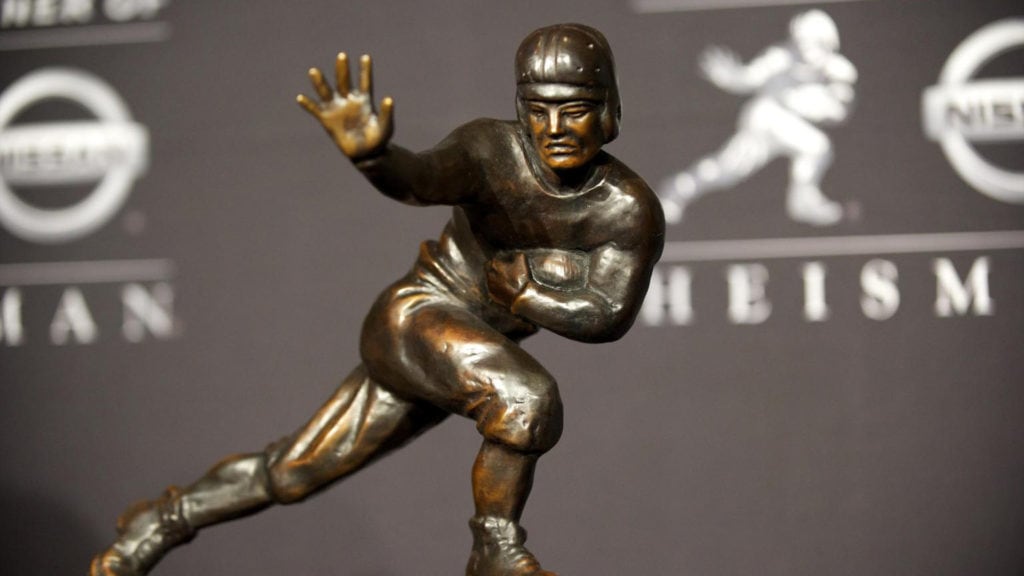The 2007 Heisman Trophy presentation will take place on December 8th, and one college football player will be honored as the best in the country. The Heisman is a great honor, but it doesn’t always ensure a lengthy professional career in football. Even Heisman winners need a back-up business plan.
Here are some former Heisman winners who, whether out of passion or necessity, achieved success in business.
Angelo Bertelli, Notre Dame, 1943
“The Springfield Rifle” won the Heisman in 1943, even though he left ND to join the Marine Corps six games into the season. After tackling the Axis Powers, Bertelli opened up a chain of liquor stores in New Jersey and Massachusetts. As if the Irish needed another reason to love this guy.
Dick Kazmaier, Princeton, 1951
Richard Kazmaier was a 6 — yes, 6 — sport athlete in high school, then played quarterback, running back, and kicker for Princeton. He took home the Heisman in 1951. Kazmaier passed on the NFL, instead opting to attend Harvard Business School. He eventually formed Kazmaier Associates, Inc., an investment and marketing firm, where he serves as President. He has also served as director of the World Federation of the Sporting Goods Industry, trustee of Princeton University, chairman of the President’s Council on Physical Fitness and Sports under Reagan and Bush, and director of the National Football Foundation and Hall of Fame. Apparently he can also fly and stop the rotation of the Earth.
Billy Vessels, Oklahoma, 1952
After winning the Heisman in ’52, Vessels had his professional career curtailed by injury. A love of horse racing led him to get involved with the Florida Pari-Mutuel Commission, an organization focused on gambling/wagering. Vessels served as executive director while simultaneously breeding horses, proving that passion and business don’t always have to be separate. He was later elected president of the National Association of State Racing Commissions. Throughout his career, Vessels enjoyed using the pick-up line, “I don’t just breed studs, I am one.”*
[*This is pure speculation.]
Howard Cassady, Ohio State, 1955
Howard “Hopalong” Cassady overcame a lame nickname to win the 1955 Heisman by scoring 15 touchdowns his senior year. After football, Cassady became an entrepreneur, starting a company that manufactured concrete pipe. In fact, one of these concrete pipes would later be used by OSU running back Maurice Clarett as a weapon during one of Clarett’s 247 lifetime criminal incidents. See, it’s important to give back to the program.
Pete Dawkins, Army, 1958
Pete Dawkins was a Heisman winner, a U.S. Army Brigadier General, a Rhodes Scholar and a candidate for Senate (…what have you done with your life?). Not surprisingly, Dawkins went on to post-football success, getting a job on Wall Street and working his way up to become CEO of Primerica Financial Services. Dawkins is currently the vice chairman of Citigroup Private Bank. So, in other words, not only could this guy beat you up and take your lunch money, but he could then use it to turn a 3000% profit.
Roger Staubach, Navy, 1963
Before he was one of the NFL’s best quarterbacks ever, Roger Staubach was the “greatest QB in Navy history,” according to his coach. Staubach was excellent in his business career as well, starting a commercial real estate company known as The Staubach Company in 1977. Staubach served as chief executive until this past June, when he decided to step down. A Naval officer who voluntarily went to Vietnam, Staubach has always shown the utmost commitment to all of his endeavors, on and off the field. In 2001, he was named the Walter Camp “Man of the Year.”
He never dated Carrie Underwood though, so Tony Romo has him beat there.
John Huarte, Notre Dame, 1964
As a senior, quarterback John Huarte won the 1964 Heisman, beating out the likes of Gale Sayers, Dick Butkus and Brian Piccolo (who’s crying now, Piccolo?). Huarte signed with the New York Jets, but ended up as the back-up QB, behind Joe Namath, who probably tried to make out with his girlfriend at some point. Nowadays, Huarte is the CEO of Arizona Tile Supply, which distributes tiles through more than 20 branches in Arizona and California.
O.J. Simpson, USC, 1968
Just kidding…
Johnny Rodgers, Nebraska, 1972
The 1972 Heisman winner, Rodgers is widely considered to be Nebraska’s greatest player ever, and is far more revered than, say, Lawrence Phillips. After an injury-plauged pro career, Rodgers proved that an interest in sports can translate into many business opportunities. He currently operates a sports marketing firm and a bedding company in Nebraska, and is in the process of opening a sports bar. Rodgers authored the book An Era of Greatness about Nebraska football, and he works with the university to encourage dropouts to return to school. He saves kittens from trees in his spare time.
John Cappelleti, Penn State, 1973
Not all Heisman winners choose post-football careers in sports. John Cappelleti won the Heisman as a running back for Penn State in 1973, back when Joe Paterno was only 84 years old. After playing the sport professionally, Cappelleti became a partner in Alpha Stainless, a company that provides fluid transfer systems and components to pharmaceutical and biotech companies. Pretty impressive. Be honest, you probably thought football players couldn’t even spell “pharmaceutical.”
It just goes to show, no matter how good someone is at football, the time will come to move on to another career. The 2007 Heisman candidates might want to take note. Except for Tim Tebow. That guy is pretty much set for life and doesn’t need to pay attention in class ever.
About Growthink
Founded in 1999, Growthink’s business plan writers have developed more than 2,000 business plans for entrepreneurs, startups and middle market companies. Call 800-506-5728 for a free business plan consultation. Or, if you’re developing your plan yourself, save time and money with Growthink’s simple business plan template.





